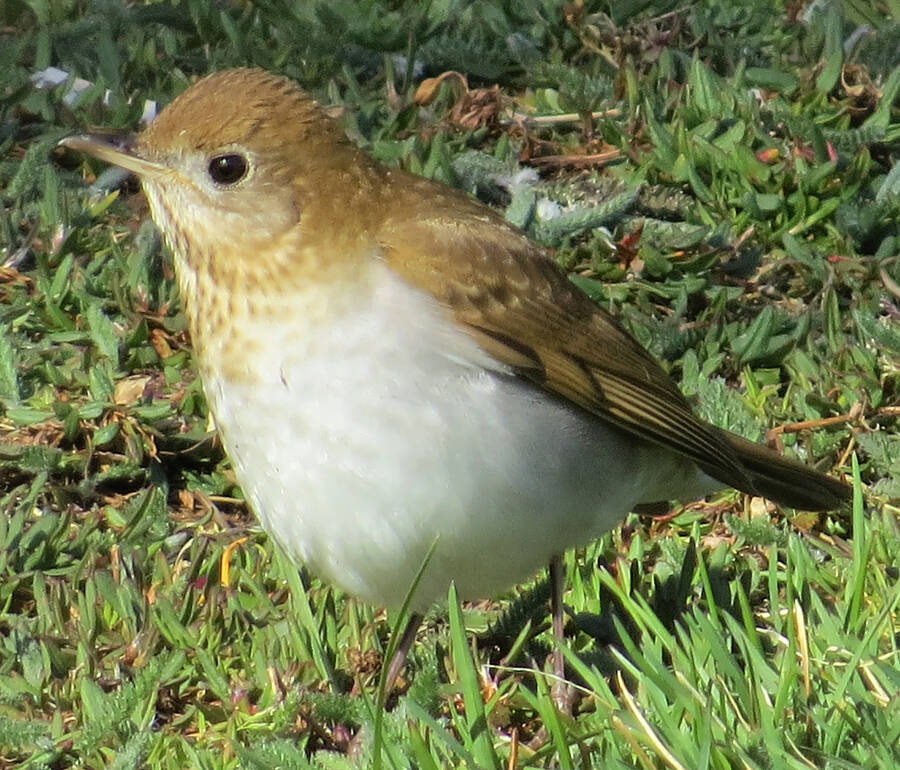
2023-05-24
A closer look at the veery
On May 7, I noticed a thrush feeding on my lawn in LaHave. This bird came back again on May 9. It was a veery.
This was the first time that I had witnessed one out in the open feeding on a lawn. The veery nests across Canada from British Columbia to Newfoundland and south through the Rocky Mountains to Arizona, South Dakota, Minnesota and east to Wisconsin, the southern edge of the Great Lakes and south to the Appalachians from New Jersey to Georgia. They winter in Central America to Brazil.
The veery is 16.25 to 19.4 cm long. The sexes are outwardly alike, being tawny above with a faintly spotted buffy breast and white below. It often forages on the forest floor, hopping along and turning over leaves with its bill. It also feeds a lot in trees.
They eat click beetles, wood borers, leaf chafers, June bugs, sawfly larvae, ants, cutworms, caterpillars of gypsy moth, spiders, sow bugs, snails and earthworms. Half of the diet is of wild fruit like juneberries, strawberries, blackberries, wild cherries, grapes, elderberries, dogwood berries, etc.
On May 13, Brian and Janice Kenefick and Minga O'Brien joined me to count birds on the Global Big Day. We drove 110 kms and we walked about eight. Minga and I were in the field for 12-and-a-half hours. I usually get between 60-70 species on this day; so we were very happy to count 72.
We had five species of shorebirds with three Wilson's snipe in Hebbville, 14 willets throughout, and at Crescent Beach 11 black-bellied plovers and one greater yellowlegs. There was a killdeer at Second Peninsula. A bank swallow is a hard bird to find around here, but we found one at Second Peninsula.
Raptors were not plentiful that day. We only found osprey, bald eagle, broad-winged hawk and red-tailed hawk. Waterfowl numbers were low with the exception of mallards and Canada geese. Also we only saw two ring-necked ducks. It was great to see three common terns at Crescent Beach and three soras at Hebbville. This is the only place that I'm aware that the sora is breeding in Lunenburg County other than on Tancook Island. A bobolink at Second Peninsula was wonderful to see as that is a species that I usually do not see so early.
We found 12 species of warblers with two magnolia warblers, 16 yellow-rumped warblers, three palm warblers, 14 northern parulas, six yellow warblers, four black-throated green warblers, six black and white warblers, one Nashville warbler, two blackburnian warblers, six ovenbirds, seven American redstarts, and three common yellowthroats. We only located one white-throated sparrow and two dark-eyed juncos, which is very low.
Ruby-crowned kinglets were missing, which is disconcerting as they are usually back early. We also found only three blue-headed vireos. The next day this species was back in goodly numbers. A least flycatcher was great to hear and back earlier than normal.
On May 14, I went out birding for only a few hours with David Walmark of Kingsburg. We were invited to visit a specific location, on the Somerset Road where I saw five yellow-bellied sapsuckers and a ruffed grouse. At home in LaHave a ruby-throated hummingbird was a treat and new for me for the year. A lot of reports for this species are now coming in as of May 13. Mary and David Walmark of Kingburg saw a group of 30 tree swallows on the wires. This is the most that they have seen there in the spring as newly arrived migrants.
On May 13, Marg Millard saw a gray catbird in East Berlin. Kevin Lantz spotted a short-billed dowitcher at the Back Oler Farm Marsh. Eric Mills had a bank swallow along Shoreline Drive in Blue Rocks. Jason Dain saw a lesser yellowlegs at Beach Meadows and Robert Keereweer was lucky in discovering a male scarlet tanager along Goat Lake Road in East Chester.
On May 14, Brian and Janice Kenefick of Riverport had a blue-winged warbler drop by their yard. Barbara McLean saw a few American redstarts, a couple of yellow warblers and a few black and white warblers along the Back Harbour Trail in Lunenburg. She also sadly sighted an electrocuted osprey that was attempting to start a nest on an electrical pole. Barbara also noted black-capped chickadees carrying nesting material. Lise Bell saw three eastern kingbirds at the borderline where Crescent Beach ends and Bush Island begins. Terry Durnavich of Green Bay reported a northern parula.
On May 13, I saw a mallard with five freshly hatched ducklings on Publicover Lake. European starlings were carrying food for young everywhere as were American robins.
Across the province, between May 11 and 15, there were a number of orchard orioles spotted. Steve McGrath had an American oystercatcher at Big Glace Bay.
On May 13, Blaine MacDonald discovered a northern rough-winged swallow at Chaswood. On the same day, Logan LaLonde found a red knot at the Saltmarsh Trail in Dartmouth. Species of birds located in the Halifax Municipality were blue grosbeak, brown thrasher and snowy egret.
Shelburne and Yarmouth counties reported least sandpipers, brown thrasher, house wren, eastern towhee, red-bellied woodpecker, Wilson's warbler and snowy egret. On May 15, Eric Mills saw an indigo bunting on Brier Island as well as six rose-breasted grosbeaks and a Baltimore oriole. Baltimore orioles showed up at many locations across the province.
You may reach me at 902-693-2174 or email jrhbirder@hotmail.com.






